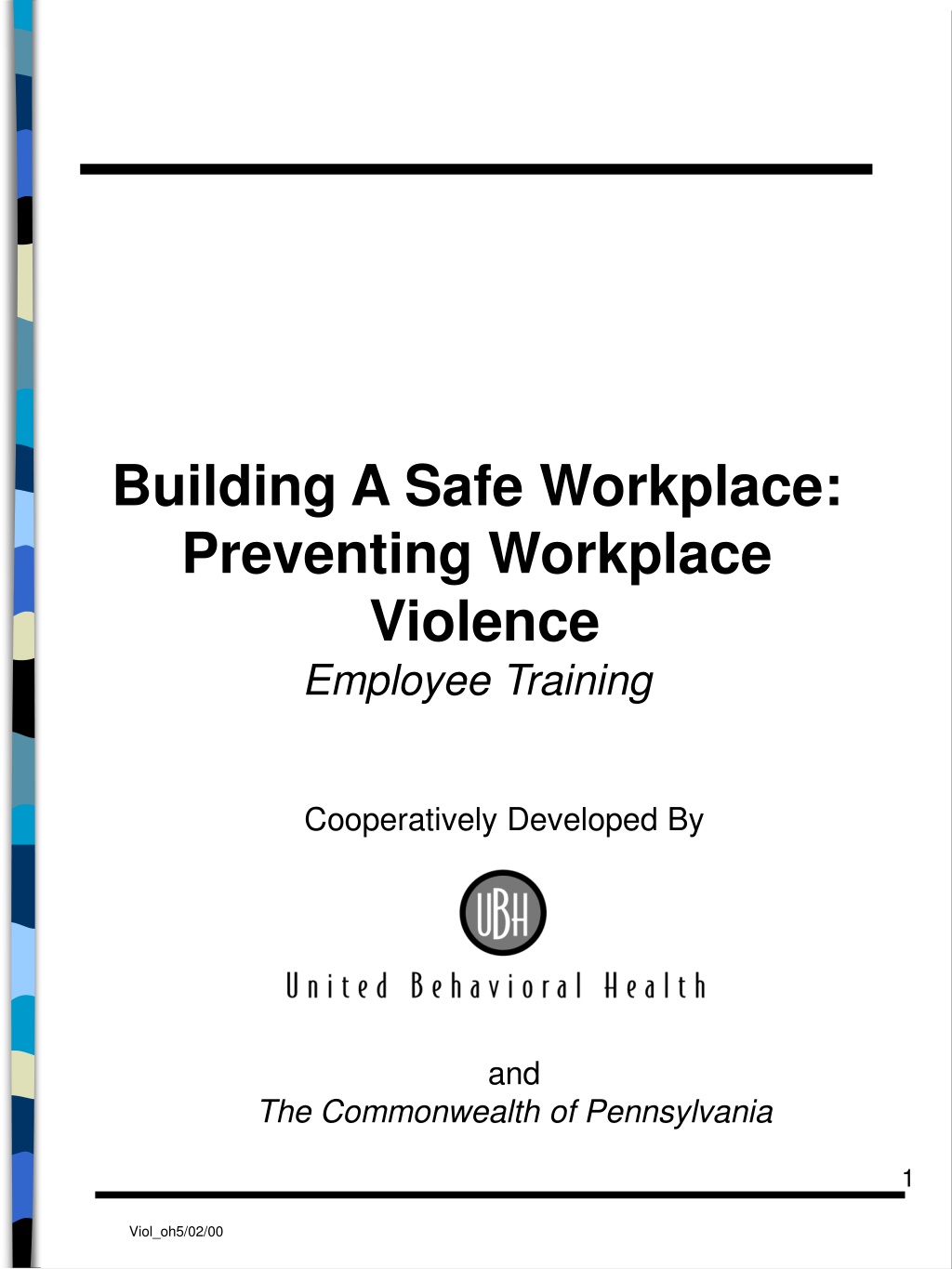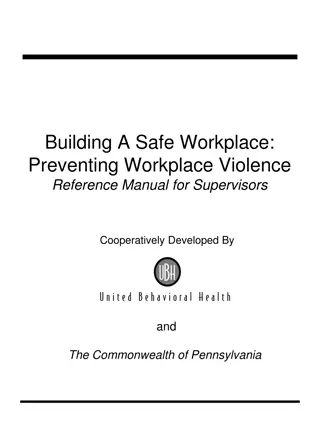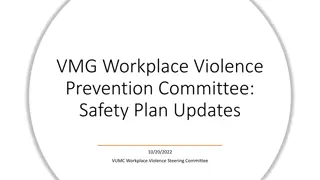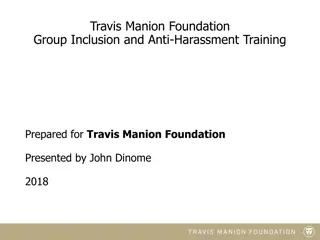Workplace Violence Prevention Training Program by Commonwealth of Pennsylvania
This program aims to educate participants on maintaining a safe workplace, identifying potential violence situations, recognizing warning signs of violence, and responding appropriately. It emphasizes the mutual responsibility of both employers and employees in ensuring a secure work environment, free from threats. The training covers employer and employee responsibilities, definitions of workplace violence, types of violent episodes, particularly focusing on domestic violence, and strategies to support victims. It also outlines a continuum of violence behaviors to help individuals recognize escalating signs.
- Workplace violence prevention
- Training program
- Safe workplace
- Employee responsibilities
- Pennsylvania
Download Presentation

Please find below an Image/Link to download the presentation.
The content on the website is provided AS IS for your information and personal use only. It may not be sold, licensed, or shared on other websites without obtaining consent from the author. Download presentation by click this link. If you encounter any issues during the download, it is possible that the publisher has removed the file from their server.
E N D
Presentation Transcript
Building A Safe Workplace: Preventing Workplace Violence Employee Training Cooperatively Developed By and The Commonwealth of Pennsylvania 1 Viol_oh5/02/00
Program Objectives 1. Participants will understand the mutual responsibility of employer and employee to maintain a safe place to work. 2. Participants will be able to identify workplace situations which may be potentially violent. 3. Participants will recognize the warning signs for potential workplace violence. 4. Participants will learn how to respond to actual or potentially violent workplace situations. 2 Viol_oh5/02/00
Employer Responsibility The Commonwealth is committed to providing a safe work environment. 3 Viol_oh5/02/00
Employee Responsibility All employees are responsible for making and reporting observations and taking measures which help to facilitate and ensure a secure workplace which is free from threats of violence. 4 Viol_oh5/02/00
Definitions Workplace Violence Assault Domestic violence Intimidating or harassing behavior -Psychological intimidation or harassment -Physical intimidation or harassment Threat SEAP 5 Viol_oh5/02/00
Types of Violent Episodes Stranger Violence Client Violence Employee Violence Domestic Violence 6 Viol_oh5/02/00
DomesticViolence Domestic violence accounts for 27% of all workplace violence Early warning signs include: increased fear emotional episodes physical injury phone calls performance decline 7 Viol_oh5/02/00
If You Know a Victim of Domestic Violence... Ask Express concern Listen Offer help Support 8 Viol_oh5/02/00
Continuum of Violence Early on in the process there may be: Refusal to cooperate Rumors and gossip Arguing Belligerence Swearing Sexual comments As feelings grow there may be: Increasing arguments Refusal Sabotaging Threats to self/ others Sending sexual, violent, or inappropriate notes Stalking As behavior escalates there may be: Threatening/attempting/ committing suicide Physical fights Destruction of property Criminal activity 9 Threatens to use/ uses weapons to harm others. Viol_oh5/02/00
What to Watch For Everyone has his or her own normal behavior. Be a good observer of unusual behavior, routine, and changes from the usual. 10 Viol_oh5/02/00
Warning Signs History of violence Mental illness A romantic obsession Chemical dependency Chronic blaming Impaired neurological functioning Increased frustration with one s circumstances Fascination with weapons Threats of revenge Absence of emotional control 11 Viol_oh5/02/00
Triggers of Workplace Violence Domestic disputes Job performance counseling or disciplinary action Job stress Harassment Racial, ethnic, cultural, gender or lifestyle conflicts Furloughs Terminations 12 Viol_oh5/02/00
Possible Motivations Individuals exhibiting violent behavior may have the following motivations: Face-saving Attention-seeking Manipulating Retaliating 13 Viol_oh5/02/00
Assault Cycle First: A traumatic experience Second: Projection of responsibility; externalization of blame Third: Self-protection and self-preservation Fourth: Internal conflict followed by committing or attempting to commit violence 14 Viol_oh5/02/00
Avoiding Victimization Be alert. Avoid unnecessary risks. Always have a plan. Let someone know where you are. Report any potential or actual incidents to your supervisor. 15 Viol_oh5/02/00
Agency Workplace Violence Coordinator Purpose: Assess Prevent Implement Communicate Recommend/ implement training Workplace hazard assessment Trauma Team. 16 Viol_oh5/02/00
How to Address Violence Early Warning Signs When the Situation Has Escalated In an Emergency 17 Viol_oh5/02/00
Addressing Potential Violence Employees have a responsibility to maintain a safe workplace. We recommend the following process to assist employees in addressing uncomfortable situations: -Think before you act. -Assess your feelings. -Describe behavior observed. -Assess behavior. -Determine whether you need assistance. -Report the threat/behavior to your supervisor. 18 Viol_oh5/02/00
Responding to a Threat: During a Confrontation When in physical jeopardy,seek safety and call law enforcement as soon as possible. Remain calm. Try not to escalate the situation. Establish an escape route. Involve witnesses. Activate response plan. Give your full attention. Restate/validate their concerns. Ask for their suggestions. Let them know what you can do. 19 Follow through. Viol_oh5/02/00
Preparing to Deal With Violence Aggressive Behavior Bomb Threats Telephone Threats Mail & Packages 20 Viol_oh5/02/00
The Obligation to Report Incidents Employees are to report any workplace situation which may contribute to the occurrence of violence to their supervisor in accordance with agency policy. Supervisors are to take appropriate action and report back to the employee in a timely manner. 21 Viol_oh5/02/00





![Workplace Violence Prevention Plan in [District]: Definitions, Elements, and Implementation](/thumb/117038/workplace-violence-prevention-plan-in-district-definitions-elements-and-implementation.jpg)



















